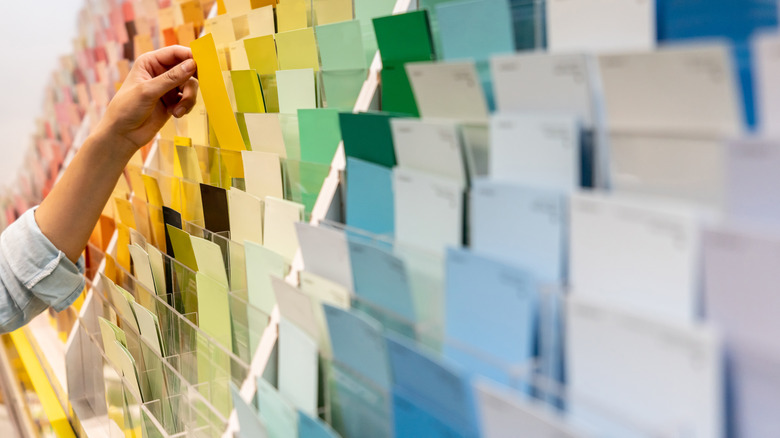The Detailed Naming Process Paint Colors Go Through Before Being Sold
So you're shopping for the perfect yellow paint colors that will brighten up your home, but as you stare down the swatches on your wall, how can you possibly decide between "Golden Groves" or "Sweet Butter?" Who creates the complex names for all these paint colors, and where is the fine line between "Cheerful" and "Pure Joy?" Believe it or not, these are examples of real yellow paint color names created by Benjamin Moore. While they might seem a little superficial at first, there is actually a logical process that goes into naming paint colors. To accurately name a hue, professional paint colorists tend to relate a physical place or object with an emotional or sensual experience, such as "Cozy Café."
However, the process is much more detailed than just slapping an appealing adjective and noun together, and the title chosen can play a big role in a customer's color decisions. Paint colorists are inspired by the world around them to describe and sell even the most unusual shades.
What's in a name?
Many paint color names a sourced from objects and experiences that surround us. "Names can typically be sorted into four descriptive categories: visual, geographical, emotional, and experiential," Diana Olvera, Behr's color marketing manager, told Consumer Reports. Geographical paint color names make up a large portion, and paint colorists may even travel in search of inspiration for the perfect name. "Santa Monica Blue" or "Savannah Clay" are some examples of travel-inspired tones. Colors are also often inspired by nature, fashion, food, or pop culture. A name like "Mystic Lake" may make consumers feel deep and down-to-earth, while "Marilyn's Dress" makes them feel sophisticated and sensual.
Aside from external inspiration, paint color names can also come from within, which is why each colorist's interpretation of the color may vary. Certain phrases and aspirations, like "Happily Ever After" or "Sweet Dreams," are often the source of color names. Other times, paint colorists rely on nostalgic and relatable experiences they've had, such as "Barefoot in the Grass" or "Grandma's China." These evocative names give buyers an idea of what the paint color will feel like in their home, perhaps reminding them of their childhood bedroom or honeymoon trip to the beach.
The hidden influence of paint color names
However shocking, serene, or silly, names have the ability to influence consumers. "When you've been staring at three shades of white paint and they all start to look the same, a name like "Fuzzy Unicorn" is exactly what you need to snap out of it and make a decision," Associate Color Marketing Manager Ashley McCollum told Realtor.com. Janet Davidson, marketing manager at Ace Hardware, points out that a name can have positive or negative ties. So color experts are careful to elicit emotions customers will connect with. She tells Consumer Reports, "We have heard in research that when it comes down to consumers' last couple of colors, sometimes it's a name preference that ultimately decides it."
However, paint color names aren't intended to sway you; instead, let them guide you and consider why the color may have been named that way. Paint colorists are experts at sensing the "mood" that a color puts off. If you're going for a warm, sweet, and calming feeling in your living room, you may want to choose "Créme Caramel" beige instead of "Pirates' Cove Beach" beige. That said, don't let the name deter you! Some beautiful shades have admittedly off-putting names — see "Desolate," "Approaching Storm," or "I've Got the Blues." If you're having trouble settling on a color, a paint colorist or consultant can also help you pick the perfect shade of paint for your home and aesthetic goals.


